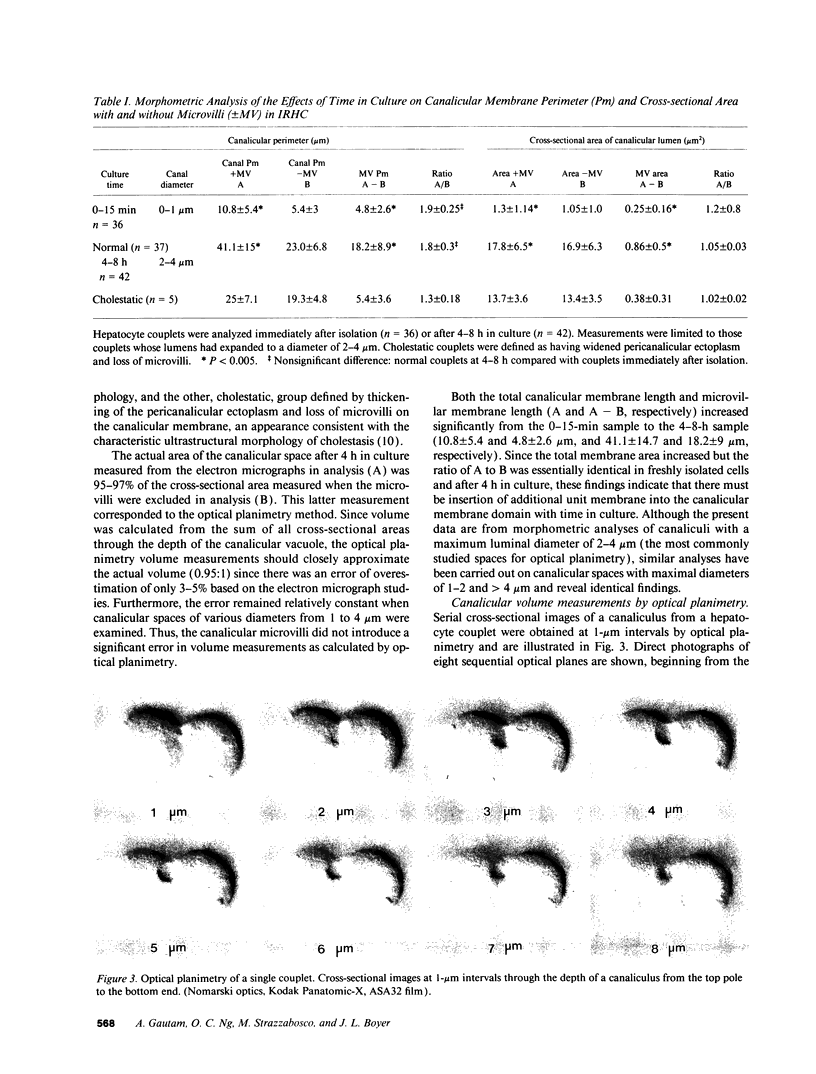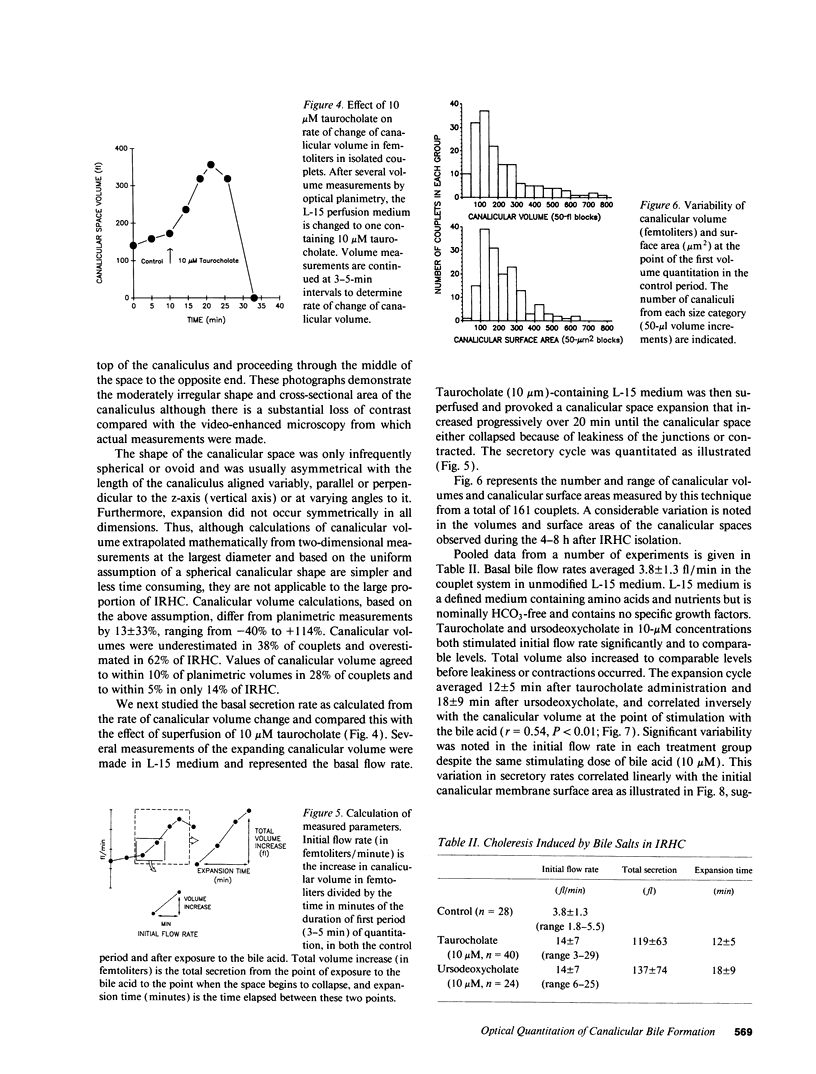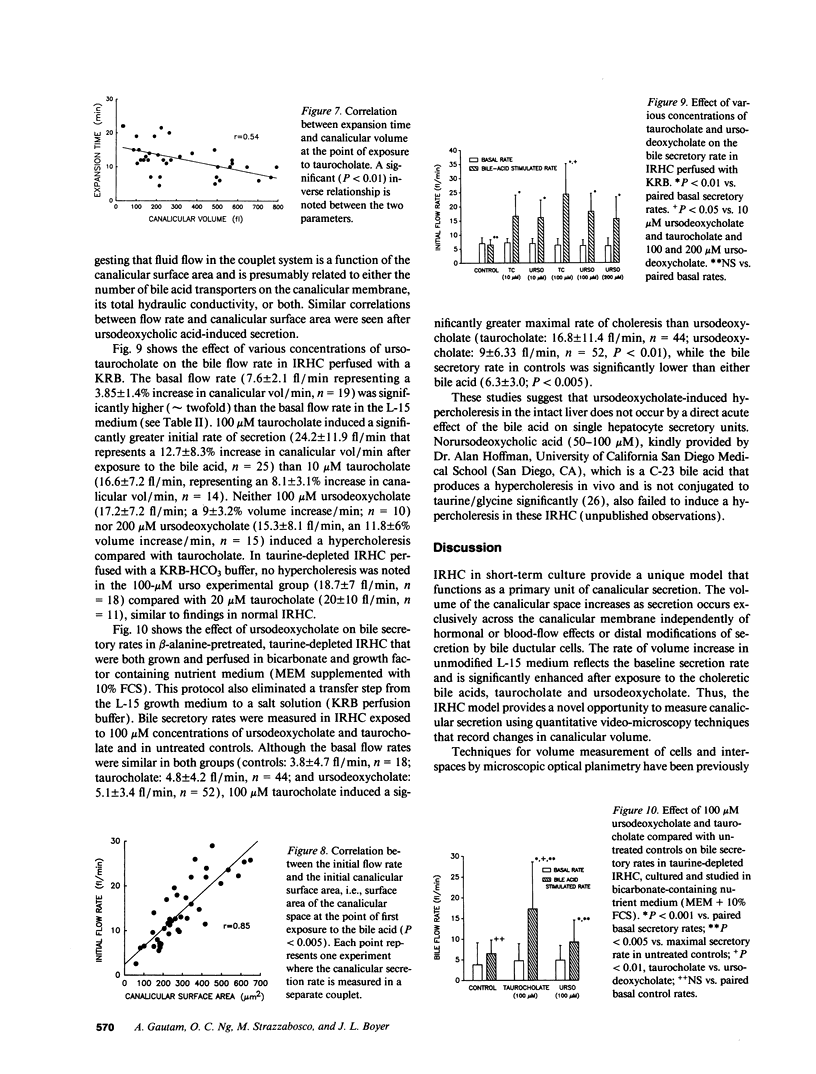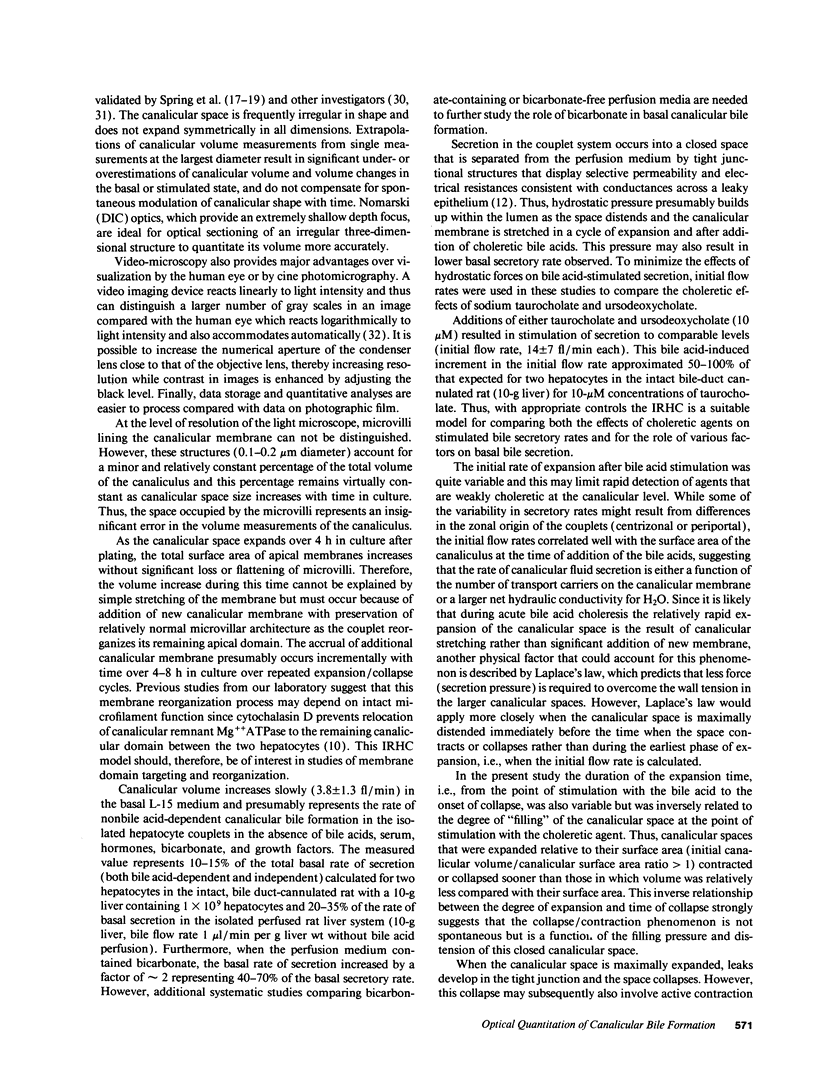Abstract
Isolated rat hepatocyte couplets (IRHC) are primary units of bile secretion that accumulate fluid in an enclosed canalicular space with time in culture. We have quantitated the rate of canalicular secretion in IRHC cultured for 4-8 h by measuring the change in canalicular space volume by video-microscopic optical planimetry using high resolution Nomarski optics. Electron microscopic morphometric studies revealed significant increases in canalicular membrane area after 4-6 h in culture. Canalicular secretion in basal L-15 medium (3.8 +/- 1.3 fl/min) increased significantly with the choleretic bile salts (10 microM), taurocholate, and ursodeoxycholate (14 +/- 7 fl/min each). Secretion rates after exposure to bile acids correlated directly with the canalicular surface area before stimulation. In contrast, expansion times after stimulation varied inversely with initial canalicular volumes. Ursodeoxycholic acid failed to produce a hypercholeresis at 10-, 100-, or 200-microM concentrations compared with taurocholate, either in normal or taurine-depleted IRHC. The present findings establish that rates of canalicular bile secretion can be quantitated in IRHC by serial optical planimetry, both in the basal state and after stimulation with bile acids. Furthermore, ursodeoxycholate does not acutely induce hypercholeresis at the canalicular level in this model. Rather, both taurocholic and ursodeoxycholic acids induced secretion in proportion to the surface area of the canalicular membrane. The IRHC are a useful model to identify canalicular choleretics and for studies of canalicular bile formation.
Full text
PDF








Images in this article
Selected References
These references are in PubMed. This may not be the complete list of references from this article.
- Arias I. M. Mechanisms and consequences of ion transport in the liver. Prog Liver Dis. 1986;8:145–159. [PubMed] [Google Scholar]
- Boyer J. L., Gautam A., Graf J. Mechanisms of bile secretion: insights from the isolated rat hepatocyte couplet. Semin Liver Dis. 1988 Nov;8(4):308–316. doi: 10.1055/s-2008-1040552. [DOI] [PubMed] [Google Scholar]
- Boyer J. L., Ng O. C., Gautam A. Formation of canalicular spaces in isolated rat hepatocyte couplets. Trans Assoc Am Physicians. 1985;98:21–29. [PubMed] [Google Scholar]
- Carpi-Medina P., Lindemann B., González E., Whittembury G. The continuous measurement of tubular volume changes in response to step changes in contraluminal osmolality. Pflugers Arch. 1984 Apr;400(4):343–348. doi: 10.1007/BF00587530. [DOI] [PubMed] [Google Scholar]
- Dumont M., Erlinger S., Uchman S. Hypercholeresis induced by ursodeoxycholic acid and 7-ketolithocholic acid in the rat: possible role of bicarbonate transport. Gastroenterology. 1980 Jul;79(1):82–89. [PubMed] [Google Scholar]
- Fisher R. S., Spring K. R. Intracellular activities during volume regulation by Necturus gallbladder. J Membr Biol. 1984;78(3):187–199. doi: 10.1007/BF01925967. [DOI] [PubMed] [Google Scholar]
- Gautam A., Ng O. C., Boyer J. L. Isolated rat hepatocyte couplets in short-term culture: structural characteristics and plasma membrane reorganization. Hepatology. 1987 Mar-Apr;7(2):216–223. doi: 10.1002/hep.1840070203. [DOI] [PubMed] [Google Scholar]
- Graf J. Canalicular bile salt-independent bile formation: concepts and clues from electrolyte transport in rat liver. Am J Physiol. 1983 Mar;244(3):G233–G246. doi: 10.1152/ajpgi.1983.244.3.G233. [DOI] [PubMed] [Google Scholar]
- Graf J., Gautam A., Boyer J. L. Isolated rat hepatocyte couplets: a primary secretory unit for electrophysiologic studies of bile secretory function. Proc Natl Acad Sci U S A. 1984 Oct;81(20):6516–6520. doi: 10.1073/pnas.81.20.6516. [DOI] [PMC free article] [PubMed] [Google Scholar]
- Graf J., Henderson R. M., Krumpholz B., Boyer J. L. Cell membrane and transepithelial voltages and resistances in isolated rat hepatocyte couplets. J Membr Biol. 1987;95(3):241–254. doi: 10.1007/BF01869486. [DOI] [PubMed] [Google Scholar]
- Henderson R. M., Graf J., Boyer J. L. Na-H exchange regulates intracellular pH in isolated rat hepatocyte couplets. Am J Physiol. 1987 Jan;252(1 Pt 1):G109–G113. doi: 10.1152/ajpgi.1987.252.1.G109. [DOI] [PubMed] [Google Scholar]
- Inoue M., Kinne R., Tran T., Arias I. M. Taurocholate transport by rat liver sinusoidal membrane vesicles: evidence of sodium cotransport. Hepatology. 1982 Sep-Oct;2(5):572–579. doi: 10.1002/hep.1840020510. [DOI] [PubMed] [Google Scholar]
- Inoue M., Kinne R., Tran T., Biempica L., Arias I. M. Rat liver canalicular membrane vesicles. Isolation and topological characterization. J Biol Chem. 1983 Apr 25;258(8):5183–5188. [PubMed] [Google Scholar]
- Kachar B., Pinto da Silva P. Rapid massive assembly of tight junction strands. Science. 1981 Jul 31;213(4507):541–544. doi: 10.1126/science.7244652. [DOI] [PubMed] [Google Scholar]
- Kitani K., Kanai S. Ursodeoxycholate-induced choleresis in taurine-deprived and taurine-supplemented rats. Jpn J Physiol. 1985;35(3):443–462. doi: 10.2170/jjphysiol.35.443. [DOI] [PubMed] [Google Scholar]
- Klaassen C. D., Watkins J. B., 3rd Mechanisms of bile formation, hepatic uptake, and biliary excretion. Pharmacol Rev. 1984 Mar;36(1):1–67. [PubMed] [Google Scholar]
- Meier P. J., Sztul E. S., Reuben A., Boyer J. L. Structural and functional polarity of canalicular and basolateral plasma membrane vesicles isolated in high yield from rat liver. J Cell Biol. 1984 Mar;98(3):991–1000. doi: 10.1083/jcb.98.3.991. [DOI] [PMC free article] [PubMed] [Google Scholar]
- Meldolesi J., Castiglioni G., Parma R., Nassivera N., De Camilli P. Ca++-dependent disassembly and reassembly of occluding junctions in guinea pig pancreatic acinar cells. Effect of drugs. J Cell Biol. 1978 Oct;79(1):156–172. doi: 10.1083/jcb.79.1.156. [DOI] [PMC free article] [PubMed] [Google Scholar]
- Miyairi M., Oshio C., Watanabe S., Smith C. R., Yousef I. M., Phillips M. J. Taurocholate accelerates bile canalicular contractions in isolated rat hepatocytes. Gastroenterology. 1984 Oct;87(4):788–792. [PubMed] [Google Scholar]
- Oshio C., Phillips M. J. Contractility of bile canaliculi: implications for liver function. Science. 1981 May 29;212(4498):1041–1042. doi: 10.1126/science.7015506. [DOI] [PubMed] [Google Scholar]
- Persson B. E., Spring K. R. Gallbladder epithelial cell hydraulic water permeability and volume regulation. J Gen Physiol. 1982 Mar;79(3):481–505. doi: 10.1085/jgp.79.3.481. [DOI] [PMC free article] [PubMed] [Google Scholar]
- Phillips M. J., Oshio C., Miyairi M., Smith C. R. Intrahepatic cholestasis as a canalicular motility disorder. Evidence using cytochalasin. Lab Invest. 1983 Feb;48(2):205–211. [PubMed] [Google Scholar]
- Renner E. L., Lake J. R., Cragoe E. J., Jr, Van Dyke R. W., Scharschmidt B. F. Ursodeoxycholic acid choleresis: relationship to biliary HCO-3 and effects of Na+-H+ exchange inhibitors. Am J Physiol. 1988 Feb;254(2 Pt 1):G232–G241. doi: 10.1152/ajpgi.1988.254.2.G232. [DOI] [PubMed] [Google Scholar]
- Sakisaka S., Ng O. C., Boyer J. L. Tubulovesicular transcytotic pathway in isolated rat hepatocyte couplets in culture. Effect of colchicine and taurocholate. Gastroenterology. 1988 Sep;95(3):793–804. doi: 10.1016/s0016-5085(88)80030-1. [DOI] [PubMed] [Google Scholar]
- Scharschmidt B. F., Van Dyke R. W. Mechanisms of hepatic electrolyte transport. Gastroenterology. 1983 Nov;85(5):1199–1214. [PubMed] [Google Scholar]
- Shaffer J. E., Kocsis J. J. Taurine mobilizing effects of beta alanine and other inhibitors of taurine transport. Life Sci. 1981 Jun 15;28(24):2727–2736. doi: 10.1016/0024-3205(81)90173-9. [DOI] [PubMed] [Google Scholar]
- Spring K. R., Hope A. Fluid transport and the dimensions of cells and interspaces of living Necturus gallbladder. J Gen Physiol. 1979 Mar;73(3):287–305. doi: 10.1085/jgp.73.3.287. [DOI] [PMC free article] [PubMed] [Google Scholar]
- Strange K., Spring K. R. Absence of significant cellular dilution during ADH-stimulated water reabsorption. Science. 1987 Feb 27;235(4792):1068–1070. doi: 10.1126/science.3823867. [DOI] [PubMed] [Google Scholar]
- Yoon Y. B., Hagey L. R., Hofmann A. F., Gurantz D., Michelotti E. L., Steinbach J. H. Effect of side-chain shortening on the physiologic properties of bile acids: hepatic transport and effect on biliary secretion of 23-nor-ursodeoxycholate in rodents. Gastroenterology. 1986 Apr;90(4):837–852. doi: 10.1016/0016-5085(86)90859-0. [DOI] [PubMed] [Google Scholar]



